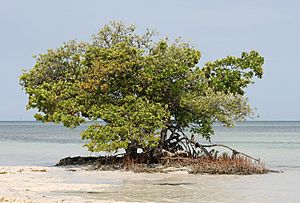Black mangrove facts for kids
The black mangrove (Avicennia germinans) is a special type of tree that grows in salty coastal areas. It's one of the main trees you'll find in a mangrove forest. Black mangroves have unique roots that help them breathe and survive in tough conditions. You can find these amazing trees in warm, tropical, and subtropical parts of Africa and the Americas.
Contents
Discovering the Black Mangrove
The black mangrove is a fascinating plant that thrives where most trees cannot: in salty ocean water! It's known for its dark bark and roots, which give it its name. These trees are super important parts of coastal ecosystems.
What is a Black Mangrove?
A black mangrove is a type of mangrove tree. Mangroves are trees or shrubs that grow in coastal saltwater or brackish water. They are found in areas like estuaries, which are where rivers meet the sea. Black mangroves are one of the most common types of mangroves.
Where Do Black Mangroves Grow?
Black mangroves love warm weather. You can find them in the tropical and subtropical regions around the world. This includes coastlines in Africa and the Americas, such as Florida in the USA, parts of Central and South America, and the Caribbean. They usually grow a little further inland than other mangroves, in areas that are flooded by high tides but exposed during low tides.
Surviving the Saltwater
Imagine trying to grow in salty water! Most plants can't do it, but black mangroves have special ways to survive. They can take in saltwater and then get rid of the extra salt. They do this by pushing salt out through special glands on their leaves. Sometimes, you can even see salt crystals on their leaves! This helps them stay healthy in their salty home.
Amazing Roots: How They Breathe
One of the coolest things about black mangroves is their unique roots. Unlike most trees, black mangroves have aerial roots called pneumatophores. These roots grow upwards out of the muddy soil, looking like pencils sticking out of the ground.
Why Pneumatophores Are Important
The soil where black mangroves grow is often very muddy and has little oxygen. The pneumatophores act like snorkels for the tree. They have tiny pores that allow the tree to take in oxygen from the air. This helps the roots breathe and keeps the tree alive in its waterlogged environment.
Why Are Mangroves Important?
Mangrove forests, including those with black mangroves, are incredibly important for both nature and people. They provide many benefits that help keep our planet healthy.
Home for Wildlife
Mangrove forests are like busy cities for many animals. The tangled roots provide safe places for young fish, crabs, and other sea creatures to hide from predators. Many birds also nest in the branches of mangrove trees. It's a vital nursery for marine life and a feeding ground for many species.
Protecting Our Coasts
These amazing trees act as natural barriers against storms and erosion. Their dense root systems help to hold the soil in place, preventing it from being washed away by waves and strong currents. This protects coastlines from damage during hurricanes and tsunamis, keeping communities safer.
Natural Water Filters
Mangroves also help keep our water clean. Their roots can trap sediments and pollutants that flow from land into the ocean. This natural filtering process helps to improve water quality, which is good for marine life and for people who rely on clean coastal waters.
Threats and Conservation
Sadly, mangrove forests around the world are facing many threats. They are often cut down for development, farming, or shrimp farms. Pollution and climate change also harm these important ecosystems.
It's super important to protect black mangroves and other mangrove species. Many groups are working to conserve and restore these valuable forests. By understanding how important they are, we can help ensure they continue to thrive for future generations.


